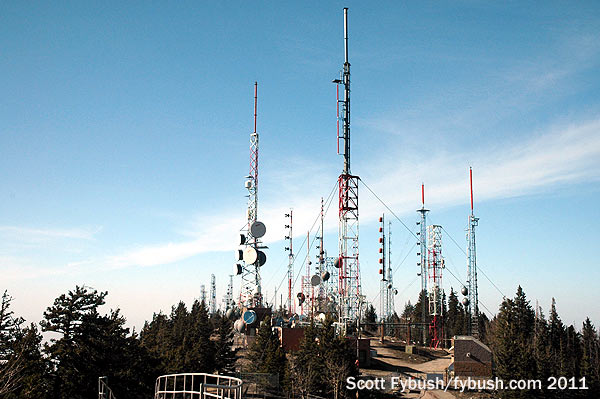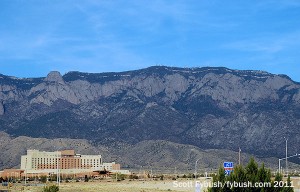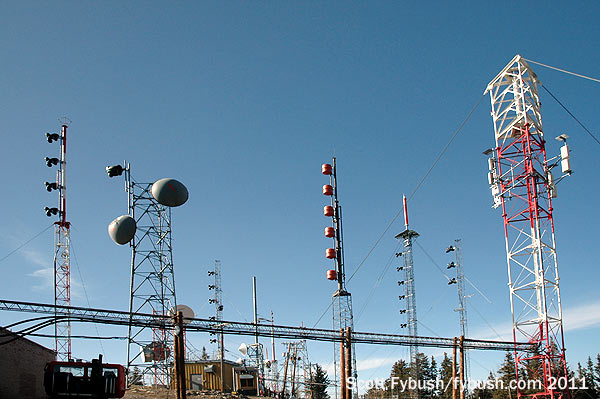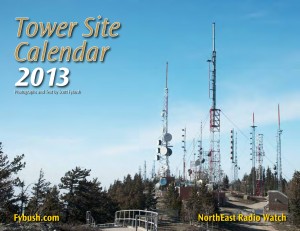NorthEast Radio Watch 11/18/2024: Sims Gets Yankees Callup
In this week’s issue… Yankees hire Dave Sims - Wallace, Maxwell move in NYC - Gray cuts news in Maine - Remembering CT's Pinto By SCOTT FYBUSH Jump to: ME - NH - VT - MA - RI - CT...
By SCOTT FYBUSH

From the days of Major Armstrong, 75 years ago, broadcasters have known that successful FM (and later TV) transmission depends most of all on one factor: height. If you’re in a big city surrounded by flat terrain, like Chicago or New York, that means a tall skyscraper is usually the best place to be located. If you’re in flat terrain without big skyscrapers – think most of the midwest and south – you turn to tall towers to get the elevation you need.
Even the very tallest of those man-made towers tops out at about 2,000 feet above ground level. That’s impressive, sure, but as you move out west, Mother Nature can do far better. Seattle’s Tiger Mountain rises more than 3,000 feet above the city, Deer Point is some 4,200 feet above downtown Boise, about the same elevation that Farnsworth Peak enjoys over Salt Lake City, and mighty Mount Wilson towers more than a mile above the beaches of southern California.
But when it comes to maximum height, one big tower farm towers above all the rest. At some 10,600 feet above sea level and nearly 5,000 feet above downtown Albuquerque, itself at about a mile of elevation, the “Sandia Crest Electronic Site” boasts lots of “mosts.” It’s the highest-elevation major tower farm in America, it boasts more high-power FM than the other big Western mountaintop sites (13 class C FMs and a C0), and perhaps most significantly, the FM and TV stations here enjoy the highest height above average terrain (HAAT) of any FM or TV stations in the continental U.S.
How high is “high”? The FM stations here range from 1232 meters (4041′) to 1294 meters (4244′) above average terrain, with the dozen full-power DTV stations ranging from 1235 to 1292 meters above average terrain.
And Sandia Crest has one other (forgive me) “signal” distinction: unlike most of those other super-elevated sites, there’s a paved road, open to the public, that can take an interested tower hunter all the way up to the gate. (There’s also an aerial tram that’s one of the city’s bigger tourist attractions, but it goes up to the ski area that’s south of the tower farm, and you can’t easily get to the towers from the top of the tram. So, drive.)
While the Sandia towers are only a dozen or so miles northeast, as the crow flies, from downtown Albuquerque, the drive up here is decidedly not a speedy affair, taking nearly an hour even when traffic’s cooperating. The towers sit atop a nearly sheer drop of more than 4500 feet down to the valley floor (the striations in the cliff face looked like a watermelon to the early settlers, it seemed, and hence the name “Sandia,” Spanish for melon), and so you can’t just drive straight up here. Instead, you keep heading east on I-40 up the hill out of Albuquerque before turning north on New Mexico 14, which runs along the east side of the crest. After six miles or so on 14, you turn west on New Mexico 536, and after another 14 miles of twists and turns, you arrive at last at a parking lot with a gift shop and snack bar on one side, and the gate to the tower farm on the other.
If you’re lucky, you’ll be rewarded with a walk to the edge of the cliff and a dramatic vista of the Rio Grande cutting through the city below and the mesas rising up to the west. If you’re us on a windy April day in 2011, you’ll be rewarded with a look down into a hazy bowl of dust. But unlike most visitors to Sandia Crest, of course, we’re here not to look down but to look up – or at least “over,” since none of the towers here needs much height to add on to the crest’s already imposing altitude. And speaking of altitude, don’t just fly into the Albuquerque airport and point your rental car up this way. Even after a couple of days at the valley’s mile-high elevation, we found ourselves panting heavily as we walked around up here at 10,600 feet.


For this site, though, we’ll work through a little altitude sickness – or even a lot of it, since these towers stretch out for almost half a mile along the mountain crest, strung out down the road that leads north from the gate. Ready for a walk? Grab your water bottle (don’t want to get dehydrated up here) and come along…just as soon as we get some history out of the way.
Albuquerque was still a small town (barely 90,000 people) when KOB-TV (Channel 4) brought television to town in 1948, so a small signal was all that was needed to cover the city. KOB-TV started out from a studio and tower site southeast of town at what’s now the city bus yard on Yale Boulevard, and it wasn’t until competition arrived in 1953 that anyone began looking for a bigger signal. By the fall of 1953, two more stations were poised to sign on – KGGM-TV (Channel 13) and KOAT-TV (Channel 7) – and KGGM and KOB were busy building up here on the crest. (KOAT instead chose to build on the mesa west of town alongside present-day I-40, and it would be several decades before channel 7 joined the rest of Albuquerque’s TV stations up here.)
Educational KNME (Channel 5) joined KOB and KGGM up here in 1958, and FM finally began arriving in 1965 with the debut of KRST (92.3), which drew its callsign from its transmitter site up on “the Crest,” followed two years later by KOB-FM (93.3) and eventually by most of the rest of the market’s FM signals in the decades that followed.


UHF signals began to sign on here in the 1970s, and in time, the FCC finally gave up on any lingering attempts to make Santa Fe, 50 miles northeast, into a separate TV market. For decades, Santa Fe broadcasters tried to either get on the air with limited Santa Fe-only signals (hobbled time and again by the very small size of that market compared to the much larger Albuquerque stations that blanketed Santa Fe from Sandia), or they attempted to use Santa Fe’s VHF allocations (commercial 2 and 11, and educational 9) up at Sandia Crest, only to face relentless opposition from the existing stations there. In the early 1990s, the FCC finally relented and allowed some of those “Santa Fe” VHF signals up here.
What had been independent KKTO (Channel 2), operating from a less-favorable site halfway between Albuquerque and Santa Fe, became Fox affiliate KASA from here on Sandia in 1992, picking up the programming from KGSW (Channel 14), which went defunct. In 2004, KNME added a digital-only sister station up here licensed to Santa Fe, KNMD (Channel 9). Of the seven VHF allocations in the combined Albuquerque/Santa Fe market, only channel 11 never made it up here – it’s religious KCHF and operates from the old KKTO site, with a better signal into Santa Fe than Albuquerque. (And yes, this is one of only a few markets with seven VHF allocations in the analog days, in the elite company of New York, Los Angeles and Salt Lake City.)
Enough history; let’s go see some towers! Befitting its status as one of the original stations up here, KRQE (Channel 13/RF 16) has its building and prominent tower just to the left of the gate. In that picture at the top of the page (and on the cover of Tower Site Calendar 2013), the KRQE tower is right at the center, with the KOB-TV (Channel 4/RF 26) tower just to the left. Up here on the mountain, the KOB site is the next one on the left – the cliff side – as we make our way past the gate and down the tower road. At the right side of those pictures – and just to the right of the gate as we head into the tower farm – is Univision affiliate KLUZ (Channel 41/RF 42), which signed on in 1987 as part of the UHF boom up here.


Making our way deeper into the tower farm, we’re surrounded by FM antennas (and by high RF levels, which is why we’re following the “occupational exposure” guidelines and not lingering here very long!) Viewed from the south, as we’re doing in that image of the “central cluster of FM towers” above, here’s the lineup: Cumulus’ KKOB-FM (93.3) is that four-bay perched right on the edge of the cliff, befitting its early arrival up here in 1967 as KOB-FM. That’s a KKOB-FM auxiliary antenna on the fat STL tower next door. In the background just to the right of the KKOB-FM aux is a tower shared by Clear Channel’s KPEK (100.3) and Family Life Radio’s KFLQ (91.5), then a tower that was the transitional site of KOB-DT and, somewhere back in there, TBN’s KNAT (Channel 23/RF 24).
The next prominent tower as we move right holds the six-bay “Tri-plex” antenna shared by Clear Channel’s KZRR (94.1), Cumulus’ KMGA (99.5) and KBZU (96.3), which operates out of Cumulus’ studios but is owned by the Citadel spinoff Last Bastion Station Trust. In the background to the right of the “Tri-plex” is the former KNME (Channel 5) analog tower, now used by KNMD (Channel 9/RF 8) and public stations KANW (89.1) and KUNM (89.9). Next to that is the three-bay antenna of Clear Channel’s KBQI (107.9), and the fat tower next to that was the old KOB-TV analog facility until 2009.
Working our way fairly steadily north along the tower road now, we pass the big KNME/KNMD building on our left, with a KUNM (89.9) aux antenna and the original low-power KNMD (RF 9) antenna mounted on the roof. The next building and tower are home mostly to low-power TV signals, though KNAT is also here on a short tower. (KNAT is the descendant of the market’s very first UHF station, KMXN, which programmed a bilingual English/Spanish format beginning in 1975.)
Two more big FMs, Cumulus’ KRST (92.3, the first FM up here) and Clear Channel’s KIOT (102.5 Los Lunas), share a tower attached to the next building to the north, across from the tower that was home to KASA’s analog channel 2 signal.
If it looks like there’s a gap in the towers where we’re standing just to the north of that building, you’re right: that’s the launch pad from which hang gliders take off for the amazing descent into the valley below.
Continuing north from the pad brings us to some newer towers up here. KWBQ (Channel 19/RF 29) and KASY (Channel 50/RF 45) share perhaps the most distinctive tower up here (right at the center in that zoomed-in image from ground level, below), which starts off as a very fat self-supporter before turning into a much narrower mast that holds the KWBQ and KASY antennas, now shared with DTV antennas for KNME (Channel 5/RF 35) and KASA (Channel 2/RF 27) as well as FM antennas for Cumulus’ KDRF (103.3) and Christian rock KLYT (88.3).


It’s KLYT that boasts the very, very highest antenna above average terrain anywhere in the country, at 1294 meters – but KDRF, mounted just on the other side of the pole, comes very close at 1293 meters. And unlike KLYT, which is a 4100-watt class C0 signal, KDRF is like most of the signals up here, a 20 kW class C.
Lower down on this tower is the two-bay antenna of the newest full-power FM up here: EMF Broadcasting swapped signals around in 2007 to move Santa Fe community station KSFR to a new home on 101.1, freeing up its old frequency, 90.7, to become a full-power C up here as K-Love outlet KQLV.
Religious independent KAZQ (Channel 32/RF 17) is on a shorter tower just to the north, and the last set of towers here belongs to ABC affiliate KOAT (Channel 7), which built a separate tower for its interim DTV signal on RF 21 and then moved its DTV back to channel 7 from the old analog antenna after the transition in 2009.
There are still more towers that dot the top of the crest going north from here, but those sticks (seen to the far left in the wide shot of the mountaintop below) are the “low-power” part of the site, home to a smattering of translators, LPTVs and non-broadcast uses.
This is truly an amazing site for VHF/UHF transmission. A few hours after we drove down the hill, we were on our way up to Santa Fe, where the Sandia FMs are still city-grade and the DTV signals (even some of the LPTVs!) were easily picked up on an indoor antenna in the hotel room. And that’s just 45 miles or so away; get in a car and drive east or west from Albuquerque on old Route 66 (or present-day I-40) and you can follow these signals for more than a hundred miles each way when the wind’s blowing the right way.
And now, a quick bit of business: It’s been a little over a year now since we transitioned Fybush.com from a completely free site to our present hybrid paywall/free content model (read what we wrote at the time right here, if you’re curious). It’s been a challenging year of dealing with daunting family health issues and, rather unexpectedly, the loss of the full-time editing gig that had made all the rest of this possible. But despite all that, thanks to all of you who’ve bought calendars and subscribed to the site, our little independent mom and pop (literally!) business is hanging on, for now.
But if you value the kind of passion this page has been bringing to our weekly looks at broadcast facilities and history for a dozen years now, and if you haven’t been supporting it with a calendar purchase or a subscription (or both!), Lisa and I hope you’ll help us out now.
Subscriptions (at as little as 29 cents a week) give you full access to our Tower Site of the Week archives going right back to the beginning in 2000 – and they give you full weekly access to our comprehensive NorthEast Radio Watch column, which has been chronicling the news of the radio and TV industry in the northeastern U.S. and eastern Canada since 1994. There’s no better bargain in radio.
If you’ve never subscribed, please consider joining us. If you’re an existing subscriber coming up on expiration time, here’s how to renew.
If you’re already a subscriber, please tell a friend or colleague about the site. Your word of mouth is the very best marketing tool we have.
And if you have a product or service you‘d like to market to our audience of broadcast engineering and management professionals, you can’t beat our economical advertising rates here on Tower Site of the Week and on NorthEast Radio Watch. Lisa’s ready to talk to you about an advertising package that you and your company can afford!


Want access to more than a dozen years’ worth of Tower Site of the Week? All our archives, fully searchable, are available to Fybush.com subscribers – and you get full access to NorthEast Radio Watch, too! Subscriptions start at just $15. Sign up here!
And don’t miss more IDs next Wednesday, over at our sister site, TopHour.com!
Next week: More previews of Tower Site Calendar 2013
In this week’s issue… Yankees hire Dave Sims - Wallace, Maxwell move in NYC - Gray cuts news in Maine - Remembering CT's Pinto By SCOTT FYBUSH Jump to: ME - NH - VT - MA - RI - CT...
In this week’s issue… iHeart axes Boston, NYC morning shows and more - Cumulus cuts in central PA - Southern Tier combo saved from silence - Ottawa FM relaunches - K-Love buys in the Burgh - Scranton gets "Loud" -...
In this week’s issue… "Hot" cools down in Providence, CT studios closed - GBH to sell Cape studios - A HEBA in Hamden? - New HDs in New York - Another Canadian AM to close
In this week’s issue… GBH shuffles mornings, prepares new show launches - NYSBA inducts Hall of Famers - More news-talk in the Hudson Valley - Remembering Dan Sys